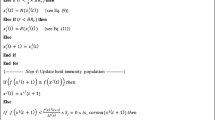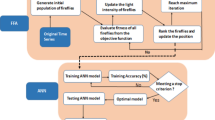Abstract
This study uses random forest (RF) analysis to present a novel method for estimating the compressive strength (Fc) of concrete made with recycled aggregate (RAC). The intricate interactions between various components make it challenging to achieve the desired Fc through the best mixture proportions. The 441 samples are used with six inputs, including Coarse Aggregate to Cement Ratio, Cement Fineness, Fine Aggregate to Total Aggregate Ratio, Specific Gravity of Saturated Surface-Dry Aggregates, and Water Absorption of Aggregates. Algorithms for machine learning (ML) and artificial intelligence (AI) have shown significant promise for solving this complexity. In addition, a semi-empirical strategy is offered that seamlessly incorporates optimization methods to improve prediction precision. The accuracy of models is improved using the Improved Grey Wolf Optimizer (IGWO) and Flying Foxes Optimization (FFO). Therefore, three distinct models are produced: RFFO, RFIG, and a standalone RF model. Each of these models provides essential insights into accurate Fc prediction for RAC. Interestingly, the RFFO model outperforms all others with a remarkable R2 value of 0.996 and a remarkably low RMSE value of 0.993. Furthermore, RF obtained a weak performance equal to 4.897 compared to other developed models, in which the RFFO achieved 0.986. These results demonstrate the RFFO model's skill in predicting RAC results while reiterating its accuracy and dependability. This technique has great potential for precise RAC prediction in the construction sector.











Similar content being viewed by others
Availability of data and materials
Data can be shared upon request.
References
Abdollahzadeh G, Jahani E, Kashir Z (2016) Predicting of compressive strength of recycled aggregate concrete by genetic programming. Comput Concrete 18(2):155–163
Ajdukiewicz A, Kliszczewicz A (2002) Influence of recycled aggregates on mechanical properties of HS/HPC. Cem Concr Compos 24(2):269–279
Akbarzadeh MR, Ghafourian H, Anvari A, Pourhanasa R, Nehdi ML (2023) Estimating compressive strength of concrete using neural electromagnetic field optimization. Materials 16(11):4200
Behnood A, Olek J, Glinicki MA (2015) Predicting modulus elasticity of recycled aggregate concrete using M5′ model tree algorithm. Constr Build Mater 94:137–147. https://doi.org/10.1016/j.conbuildmat.2015.06.055
Biau G, Scornet E (2016) A random forest guided tour. TEST 25:197–227
Casuccio M, Torrijos MC, Giaccio G, Zerbino R (2008) Failure mechanism of recycled aggregate concrete. Constr Build Mater 22(7):1500–1506. https://doi.org/10.1016/j.conbuildmat.2007.03.032
Dilbas H, Şimşek M, Çakır Ö (2014) An investigation on mechanical and physical properties of recycled aggregate concrete (RAC) with and without silica fume. Constr Build Mater 61:50–59. https://doi.org/10.1016/j.conbuildmat.2014.02.057
Duan ZH, Poon CS (2014) Properties of recycled aggregate concrete made with recycled aggregates with different amounts of old adhered mortars. Mater Des 58:19–29. https://doi.org/10.1016/j.matdes.2014.01.044
Duan Z-H, Kou S-C, Poon CS (2013a) Prediction of compressive strength of recycled aggregate concrete using artificial neural networks. Constr Build Mater 40:1200–1206. https://doi.org/10.1016/j.conbuildmat.2012.04.063
Duan Z-H, Kou S-C, Poon CS (2013b) Using artificial neural networks for predicting the elastic modulus of recycled aggregate concrete. Constr Build Mater 44:524–532. https://doi.org/10.1016/j.conbuildmat.2013.02.064
Duan J, Asteris PG, Nguyen H, Bui X-N, Moayedi H (2021) A novel artificial intelligence technique to predict the compressive strength of recycled aggregate concrete using ICA-XGBoost model. Eng Comput 37:3329–3346
Folino P, Xargay H (2014) Recycled aggregate concrete–mechanical behaviour under uniaxial and triaxial compression. Constr Build Mater 56:21–31. https://doi.org/10.1016/j.conbuildmat.2014.01.073
Gao Z-M, Zhao J (2019) An improved grey wolf optimization algorithm with variable weights. Comput Intell Neurosci 2019:1–13
Gholampour A, Gandomi AH, Ozbakkaloglu T (2017) New formulations for mechanical properties of recycled aggregate concrete using gene expression programming. Constr Build Mater 130:122–145. https://doi.org/10.1016/j.conbuildmat.2016.10.114
Golafshani EM, Behnood A (2018) Application of soft computing methods for predicting the elastic modulus of recycled aggregate concrete. J Clean Prod 176:1163–1176
Golafshani EM, Behnood A (2018) Automatic regression methods for formulation of elastic modulus of recycled aggregate concrete. Appl Soft Comput 64:377–400. https://doi.org/10.1016/j.asoc.2017.12.030
Gonzalez-Fonteboa B, Martinez-Abella F, Eiras-Lopez J, Seara-Paz S (2011) Effect of recycled coarse aggregate on the damage of recycled concrete. Mater Struct 44(10):1759–1771. https://doi.org/10.1617/s11527-011-9736-7
Han T, Siddique A, Khayat K, Huang J, Kumar A (2020) An ensemble machine learning approach for prediction and optimization of modulus of elasticity of recycled aggregate concrete. Constr Build Mater 244:118271
Haupt RL, Haupt SE (2004) Practical genetic algorithms. John Wiley & Sons
Haykin S (2009) Neural networks and learning machines, 3rd edn. China Machine Press
Hoang N-D (2023) “A novel ant colony-optimized extreme gradient boosting machine for estimating the compressive strength of recycled aggregate concrete.” Multiscale Multidiscip Model Exp Des. https://doi.org/10.1007/s41939-023-00220-6
Isgor OB, Ideker J, Fu T, Adams MP (2013) Cracking susceptibility of concrete made with recycled concrete aggregate. OTREC-SS-725. Transportation Research and Education Center (TREC), Portland, OR. https://doi.org/10.15760/trec.50
Khan K, Ahmad W, Amin MN, Aslam F, Ahmad A, Al-Faiad MA (2022) Comparison of prediction models based on machine learning for the compressive strength estimation of recycled aggregate concrete. Materials 15(10):3430. https://doi.org/10.3390/ma15103430
Kou S, Poon C, Agrela F (2011) Comparisons of natural and recycled aggregate concrete prepared with the addition of different mineral admixtures. Cem Concr Compos 33(8):788–795
Kulkarni AD, Lowe B (2016) “Random forest algorithm for land cover classification,”
Kumar S, Tejani GG, Mirjalili S (2019) Modified symbiotic organisms search for structural optimization. Eng Comput 35(4):1269–1296
Kumar S, Tejani GG, Pholdee N, Bureerat S (2021) Multi-objective passing vehicle search algorithm for structure optimization. Expert Syst Appl 169:114511
Lin W, Wu Z, Lin L, Wen A, Li J (2017) An ensemble random forest algorithm for insurance big data analysis. IEEE Access 5:16568–16575
Liu Z, Jiang P, Wang J, Zhang L (2021) Ensemble forecasting system for short-term wind speed forecasting based on optimal sub-model selection and multi-objective version of mayfly optimization algorithm. Expert Syst Appl 177:114974
Lovato PS, Possan E, Dal Molin DCC, Masuero ÂB, Ribeiro JLD (2012) Modeling of mechanical properties and durability of recycled aggregate concretes. Constr Build Mater 26(1):437–447
Nadimi-Shahraki MH, Taghian S, Mirjalili S (2021) An improved grey wolf optimizer for solving engineering problems. Expert Syst Appl 166:113917
Nobile MS, Cazzaniga P, Besozzi D, Colombo R, Mauri G, Pasi G (2018) Fuzzy self-tuning PSO: a settings-free algorithm for global optimization. Swarm Evol Comput 39:70–85
Onyelowe KC, Gnananandarao T, Ebid AM, Mahdi HA, Ghadikolaee MR, Al-Ajamee M (2022) Evaluating the compressive strength of recycled aggregate concrete using novel artificial neural network. Civil Eng J 8(8):1679–1693
Rahal K (2007) Mechanical properties of concrete with recycled coarse aggregate. Build Environ 42(1):407–415. https://doi.org/10.1016/j.buildenv.2005.07.033
Safarian S, Ebrahimi Saryazdi SM, Unnthorsson R, Richter C (2021) Modeling of hydrogen production by applying biomass gasification: artificial neural network modelling approach. Fermentation 7(2):71
Sarica A, Cerasa A, Quattrone A (2017) Random forest algorithm for the classification of neuroimaging data in Alzheimer’s disease: a systematic review. Front Aging Neurosci 9:329
Schoppe BM (2011) Shrinkage & modulus of elasticity in concrete with recycled aggregates. Master’s Theses. https://doi.org/10.15368/theses.2011.62
Shi C, Li Y, Zhang J, Li W, Chong L, Xie Z (2016) Performance enhancement of recycled concrete aggregate–a review. J Clean Prod 112:466–472
Sullivan E (2022) Understanding from machine learning models. Br J Philos Sci. https://doi.org/10.1093/bjps/axz035
Tavana Amlashi A, Mohammadi Golafshani E, Ebrahimi SA, Behnood A (2023) Estimation of the compressive strength of green concrete containing rice husk ash: a comparison of different machine learning approaches. Eur J Environ Civ Eng 27(2):961–983. https://doi.org/10.1080/19648189.2022.2068657
Thomas C, Setién J, Polanco J, Alaejos P, De Juan MS (2013) “Durability of recycled aggregate concrete.” Constr Build Mater 40:1054–1065
Tsafarakis S, Zervoudakis K, Andronikidis A, Altsitsiadis E (2020) Fuzzy self-tuning differential evolution for optimal product line design. Eur J Oper Res 287(3):1161–1169
Wang H, Lei Z, Zhang X, Zhou B, Peng J (2016) “Machine learning basics,” Deep Learn, 98–164
Wardeh G, Ghorbel E, Gomart H (2015) Mix design and properties of recycled aggregate concretes applicability of Eurocode 2. Int J Concr Struct Mater 9:1–20
Xu J, Zhao X, Yu Y, Xie T, Yang G, Xue J (2019) Parametric sensitivity analysis and modelling of mechanical properties of normal-and high-strength recycled aggregate concrete using grey theory, multiple nonlinear regression and artificial neural networks. Constr Build Mater 211:479–491
Zega CJ, Di Maio AA (2009) Recycled concrete made with different natural coarse aggregates exposed to high temperature. Constr Build Mater 23(5):2047–2052. https://doi.org/10.1016/j.conbuildmat.2008.08.017
Zervoudakis K, Tsafarakis S (2022) A global optimizer inspired by the survival strategies of flying foxes. Eng Comput. https://doi.org/10.1007/s00366-021-01554-w
Zhou ZH (2021) Machine learning. Springer Nature, Singapore
Acknowledgements
This work was supported by the Science and Technology Research Program of the Chongqing Municipal Education Commission (Grant NO. KJQN202105702).
Author information
Authors and Affiliations
Contributions
The author contributed to the study's conception and design. Data collection, simulation and analysis were performed by “Qiuyun Wang”.
Corresponding author
Ethics declarations
Conflict of interest
The authors declare no conflict of interests.
Additional information
Publisher's Note
Springer Nature remains neutral with regard to jurisdictional claims in published maps and institutional affiliations.
Rights and permissions
Springer Nature or its licensor (e.g. a society or other partner) holds exclusive rights to this article under a publishing agreement with the author(s) or other rightsholder(s); author self-archiving of the accepted manuscript version of this article is solely governed by the terms of such publishing agreement and applicable law.
About this article
Cite this article
Wang, Q. Estimation of compressive strength of recycled aggregate concrete using advanced meta-heuristic algorithms and random forest analysis. Multiscale and Multidiscip. Model. Exp. and Des. (2024). https://doi.org/10.1007/s41939-024-00413-7
Received:
Accepted:
Published:
DOI: https://doi.org/10.1007/s41939-024-00413-7




